There are 11 types of turtles in Massachusetts. Ten of these species are native to Massachusetts, while one is a non-native turtle.
Some are terrestrial, while others are aquatic, not including sea turtles, which can be found offshore. In 2014, it became illegal to own or sell the non-native Red-eared Slider due to the threat of spreading salmonella.
Most of these turtles have a specific habitat, preferred food, and nesting season. By closely observing the turtle’s carapace and plastron, you can determine the species that lives in Massachusetts.
If you want to learn more about each turtle’s specifics, continue reading the article.
Turtles in Massachusetts
1. Blanding’s Turtle
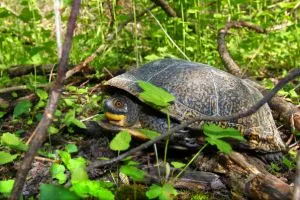
- Experience Level: Expert
- Family: Emydidae
- Scientific Name: Emys blandingii or Emydoidea blandingii
- Size: 7 and 10 inches
- Lifespan: 60 and 80 years
- Average Price Range: $349.95 – $449.95
Blanding’s turtles are known for their domed and black upper shell. The carapace has yellow markings that may be faded in some turtles. You can recognize them by their bright yellow chin and throat.
The plastron is different from the carapace, as it is yellow with a dark spot in each scute. Some might be entirely black.
The habitat of this type of turtle varies from shallow lakes to ponds and wetlands with clean water. The species favors soft bottoms where it hibernates. When spring comes, you can see the Blanding’s turtles basking in sunny locations.
Female turtles of this type mature when around 14, and can have a lifespan of over 75 years. Eggs are typically laid between May and June, and the gender of the turtle will be determined by their incubation temperature.
They are omnivores, which means they feed on insects, fish, frogs, and vegetation plants.
2. Bog Turtle
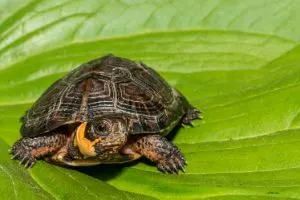
- Experience Level: Expert
- Family: Emydidae
- Scientific Name: Glyptemys muhlenbergii
- Size: 4 inches when fully grown
- Lifespan: 20 to 30 years
The Bog turtle is the smallest type of turtle in North America. The upper shell has a rectangular shape that is narrower at the head and wider at the tail.
The color of the shell is black, the same as the skin. The inside side of the legs is orange or red. There is a yellow spot on each side of the neck.
This type of turtle gets its name from the place where it lives. The Bog turtle favors bogs, wetlands, and meadows. They are semi-aquatic, which means they live both on land and in water.
Like all other aquatic and semi aquatic turtles they need to bask, so you will see them laying out in the sun.
Just like the Blanding’s turtle, the Bog turtles are omnivorous. They feed on aquatic plants, snails, insects, slugs, and earthworms.
3. Northern Diamondback Terrapin

- Experience Level: Intermediate to Expert
- Family: Emydidae
- Scientific Name: Malaclemys terrapin
- Size: 5,1 inches (males), 7,5 inches (females)
- Lifespan: 60 and 80 years
- Average Price Range: $249.00 – $299.95
- Recommended Books: Map Turtles and Diamondback Terrapins (Herpetology Series) by W.P. Mara
Diamondback terrapins spend most of their lives in brackish water and is the only type that does this.
The Northern Diamondback Terrapin which is a subspecies of the Diamondback is a medium-sized turtle. Similar to slider turtles females will be significantly larger than males.
Another difference between the males and females is that females have a short and narrow tail, while males have a long and thicker one.
The color of their carapace varies from gray, brown to black. Their plastron is greenish-yellow while their skin is gray with black sports and other dark markings.
The name of the turtle comes from their diamond-shaped pattern on their carapace.
Males are better swimmers than females because of the strong webbed feet. Like the other subspecies of Diamondbacks, they have strong jaws to crush the clams when eating.
4. Eastern Box Turtle
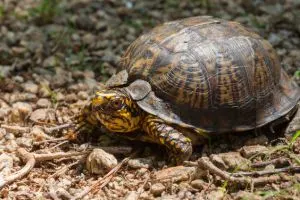
- Experience Level: Beginner
- Family: Emydidae
- Scientific Name: Terrapene carolina carolina
- Other Names: Land Turtle
- Size: 4 to 7 inches
- Lifespan: 40 years
- Average Price Range: $260 – $360
- Recommended Books: Box Turtles (Complete Herp Care) by Tess Cook
The Eastern Box turtle is one of the six subspecies of the Common Box turtle. The carapace is high-domed, rounded, and hard. There are orange and yellow markings on the brown carapace.
The plastron is dark brown and hinged. When in danger, the turtle pulls its body into its shell. The shell is unique because it can regenerate.
This turtle species has a hooked upper jaw and a pronounced overbite. The feet are strong and webbed, the same as the Northern Diamondback turtle. Males have shorter and thicker tails than females.
Eastern Box turtles are terrestrial, so they prefer living in vegetative areas, marshy meadows, open woodlands, and field forest edges.
They are omnivores, which means they feed on plants, fruits, fish, insects, eggs, and animal carrion. Hatchlings grow very fast, and they tend to be carnivorous.
5. Eastern Musk Turtle
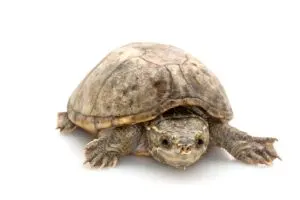
- Experience Level: Intermediate
- Family: Kinosternidae
- Scientific Name: Sternotherus Odoratus
- Other Names: Common Musk Turtle; Stinkpot
- Adult Size: Between 4 and 5 inches
- Lifespan: 50 years and over
- Average price range: Between $20 and $90
The color of the Eastern Musk turtle or the Stinkpot varies from gray, black, or brown. The name of the turtle comes from the odor that the turtle releases from its glands.
They have a relatively long lifespan and can live up to 50 years. You can recognize the turtle by the domed shell and the two light-colored stripes on their head.
Eastern Musk turtles favor slow-moving and still waters with soft and muddy bottoms.
They are omnivores, so they prey on aquatic animals, plants, and carrion. The nesting season begins in May and lasts until September.
Females are lareger than males with a triangle-shaped head, pointed snout, and a sharp beak.
6. Northern Red-bellied Cooter

- Experience Level: Beginner
- Family: Emydidae
- Scientific Name: Pseudemys rubriventris
- Other Names: American Red-bellied Turtle
- Adult Size: 12 inches (males), up to 16 inches (females)
- Lifespan: Up to 60 years
- Average price range: Around $70
- Where to buy: theturtlesource.com
- Recommended book: Aquatic Turtles: Sliders, Cooters, Painted, and Map Turtles (Reptile Keeper’s Guide) by R.D. Barlett
The carapace and skin of the turtle can be dark brown or black. There is a red pattern in the front part of the shell that is more pronounced at the edges.
The underside of the shell is red with a black pattern in the middle. The stripes on the skin can be white, yellow, or red.
The Northern Red-bellied Cooter is a reasonably large turtle and can live up to 60 years.
The older the turtle gets, the darker it becomes and loses its green color from when they were hatchlings.
They will typically be found in still waters, such as lakes and ponds. Diet wise they are an herbivore and feed on aquatic plants.
Nesting season begins earlier in the spring and lasts until June. The incubation period is around 80 days.
7. Eastern Painted Turtle
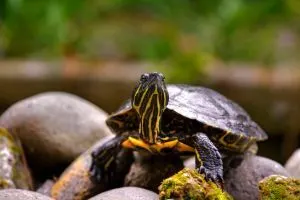
- Experience Level: Beginner
- Family: Kinosternidae
- Scientific Name: Chrysemys picta picta
- Other Names: Sun Turtle
- Adult Size: 4 to 10 inches
- Lifespan: 30 to 40 years
- Average price range: Between $70 and $130, depending on the subspecies
- Recommended Books: Painted Turtle Pet Owners Guide by Ben Team
Eastern painted turtles have a long and oval. Their carapaces color can be olive or black, while their plastron is a yellow or red with dark markings in the center.
They are an aquatic reptile and prefer to spend most of their time in water, typically marches, ponds, lakes and creeks. Freshwaters with aquatic vegetation and soft bottoms are the turtle’s favorites.
This type of turtle is an omnivore; however, adult turtles are more herbivorous, while juveniles prefer eating meat.
A typical diet will consist of aquatic plants, insects, fish, and carrion.
Mating seasing is in spring, and courtship starts after they meet face-to-face. Nesting season begins in late May and mid-July.
8. Common Snapping Turtle

- Experience Level: Intermediate
- Family: Chelydridae
- Scientific Name: Chelydra serpentina
- Other Names: Common Snapping Turtle
- Adult Size: 8 to 20 inches
- Lifespan: 30 to 50 years
- Average price range: Between $20 and $40
- Recommended Books: Snapping Turtle Pet Owners Guide. The Captive Care of Snapping Turtles. Including Snapping Turtles Biology, Behavior, and Ecology.
The Common snapping turtle, inhabits all sorts of water bodies, such as rivers, lakes, and marshes. Since it’s a freshwater turtle, it prefers hiding underwater in sediment.
The turtle’s carapace has three ridges, while their neck can stretch the length of the shell. This type of turtle may be aggressive if it feels threatened. The carapace of the turtle is rugged, with ridges that are more pronounced in hatchlings.
They are also known to have a delayed sexual maturity and extended longevity.
Diet wise they are omnivorous, so fish, frogs, reptiles, invertebrates, and small mammals are part of their daily food intake.
9. Spotted Turtle
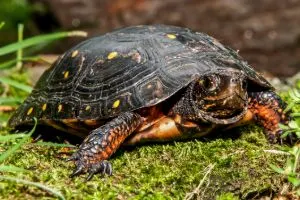
Quick Facts
- Experience Level: Intermediate to Expert
- Family: Emydidae
- Scientific Name: Clemmys Guttata
- Adult Size: 4 to 5 inches
- Lifespan: Males up to 65 years; females up to 110 years
- Average Price Range: $200 to $300
- Recommended Books: BASICS – Ecology, Husbandry & Breeding Spotted & Wood Turtles by Andreas S. Hennig
Spotted turtles ares a semi-aquatic turtle species, and live in lakes, swamps, wet meadows, and marshes.
The size can vary; however, they are known to be small turtles. Their small size makes them the perfect for many turtle lovers.
These are a bit more difficult to care for than say a slider turtle, but with some guidance should be managable.
They are omnivores that will be eating aquatic vegetation and invertebrates.
To tell the gender, some common differences include males having a concave plastron, while females will have convex ones.
Another difference is in their tails and eyes. Males have thicker tails and brown eyes, while females have thinner tails and red eyes.
10. North American Wood Turtle

- Experience Level: Beginner
- Family: Emydidae
- Scientific Name: Glyptemys insculpta
- Adult Size: 7 to 8.25 inches
- Lifespan:40 to 58 years
- Recommended Books: BASICS – Ecology, Husbandry & Breeding Spotted & Wood Turtles by Andreas S. Hennig
The North American Wood turtle is one species of wood turtle that is endemic to North America, and turtle enthusiasts can spot it in Massachusetts.
The most noticeable characteristic of the turtle is the pyramidal shape of the scutes on the carapace. The length of the carapace can be up to 8 inches.
When exploring the species in Massachusetts, be mindful that the Wood turtle is similar to the Bog turtle, Spotted turtle, and Blanding’s turtle, all of which can be found in the same place.
The species spends most of its time in the water that is clear and shallow. It can also be found in forested areas. Like other turtle species found in Massachusetts, the Wood turtle is an omnivore and can eat on land and in water.
After the mating and nesting seasons is over, the female turtle will cover the nest with leaves to protect the eggs from predators. Afterward, it leaves the nest until the next mating season approaches.
11. Red-eared Slider
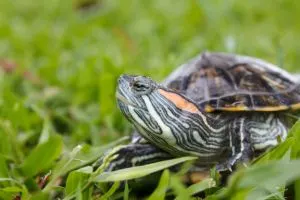
- Experience Level: Beginner
- Family: Emydidae
- Scientific Name: Trachemys scripta elegans
- Other Names: Red-eared Terrapins, Red-eared slider turtle, Red-eared turtle, Slider turtle, and Water Slider turtle
- Size: 7 to 11 inches
- Lifespan: 30 to 40 years
- Average Price Range: $20
The Red-eared slider is a semi-aquatic turtle species, which is a subspecies of the Pond Slider. It is a trendy pet not just in the United States but also worldwide. Due to this fact, the Red-eared slider is the traded turtle species in the world.
They are actually listed as one of the most invasive species, which has a lot to do with people buying them as a small pet and then releasing them in the wild once they get larger. – Please don’t ever do this.
Their names come from the red stripes behind their ears (yes turtles have ears) and the ability to jump from the rocks and logs into the water.
The typical size of the turtle varies from 7 to 11 inches. The same as many turtles, females are larger than males. The lifespan of the turtle ranges from 30 to 40 years, with some living longer than others. When kept in captivity, their life expectancy decreases.
Like most turtle species, the Red-eared slider is an omnivore and likes to eat meat, fruits, vegetables, and aquatic plants.
Conclusion
Those are the 11 turtle species found in Massachusetts. Technically only 10 are native since the Red-eared slider snuck in there somehow.
Depending on your experience level, some turtles can make excellent pets, while others are best to be left in their habitats.
If you do want a pet turtle, only buy from captive bred retailers. Most pet shops have wild caught which can come with problems and also destroys the worlds habitats.
While most of the turtles in Massachusetts are omnivores, some hatchlings prefer eating only meat as they need protein for proper development.
Nesting season may vary though usually begins in March and lasts until the end of summer.
Most female turtles are bigger than males and have delayed sexual maturity. Clutch sizes depend on several factors, including species, size, habitat, and sexual maturity.
Other nearby states
- Turtles in Europe
- Turtles in Connecticut
- Turtles in New Hampshire
- Turtles in New York
- Turtles in Rhode Island
